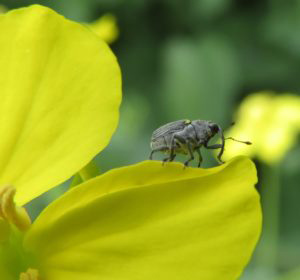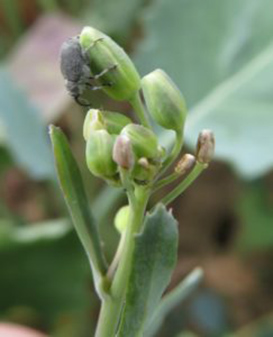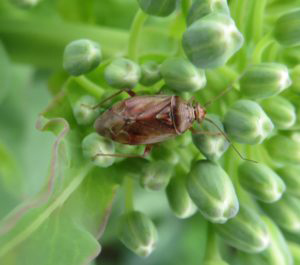Cabbage seedpod weevil (CSW) are being found in spring canola, particularly in earlier planted fields that are beginning to flower. CSW may begin to appear just prior to bolting and can primarily be found on flower buds until pods begin to form. They are approximately 3 to 4 mm in length and are fairly easy to identify by their dark grey colour and prominent curved snout (Figure 1).

Figure 1. Adult cabbage seedpod weevil
Adult weevils will feed on flower buds causing bud abortion, but the adult feeding damage rarely causes economic yield losses (Figure 2). Where there is adequate moisture, the canola plant can compensate for some loss of buds. Yield reduction is caused by the CSW larvae, which feed on seeds within developing pods and create exit holes leading to shatter losses. The key to protecting yield is to prevent adult CSW from laying eggs in newly formed pods. Adults do not lay eggs on until pods are approximately 2 cm long.
While CSW may be more abundant and easy to see at the edge of the field, growers are encouraged to follow appropriate scouting procedures using a sweep net and not apply insecticides too soon. If insecticides are applied too early, new flushes of CSW may invade the crop and lay eggs in developing pods leading to yield loss. Registered insecticides are only labelled for one application per season for CSW control so target the application when pods are developing to provide the most protection. Spraying during flowering but prior to pods developing on the plant may only be warranted if conditions are very dry, delaying plant growth, and the CSW are above threshold.

Figure 2. Pods abortion caused by CSW feeding rarely causes economic damage.
Adult CSW populations should be monitored from the first appearance of flower buds through to the end of flowering. Earliest flowering fields will be most attractive to the adults. Scout fields using a sweep net; conduct 10 sweeps (180° from shoulder to shoulder) across the top of the plants in ten different locations within the field and count the number of weevils. Sweeps should be conducted in the interior of the field as well as the perimeter. The threshold is an average of 2-4 per sweep (greater than 20 per 10 sweeps). Insecticides should be applied at 10% to 20% bloom (when plants have approximately 3 to 10 open flowers) to protect developing pods. Continue to monitor populations through to the end of flowering. Spray in the evening to reduce the risk to pollinators that will be foraging the crop. Insecticides can be added to fungicide in a one-pass system if CSW reach threshold during appropriate timing for control of white mould (20% to 50% bloom)
While conducting sweeps, keep an eye out for tarnished plant bugs (Figure 3) and other lygus species. Tarnished plant bugs are a native species that also feed on buds and pods using sucking mouthparts. As adults, they are 6 mm long with long legs and antennae. Nymphs are green but as they become adults, their colouration changes to a mottled reddish brown. Tarnished plant bug are active flyers; they fly off when approached and quickly escape the sweep net when it is opened. Bud clusters may appear twisted from feeding and are a clue to look for this insect. Again, the canola plant can compensate for feeding on buds if they have adequate moisture. Thresholds have not been validated in Ontario, but other jurisdictions suggest a threshold of 1 to 2 per sweep (8 to 20 per 10 sweeps) from the end of flowering through early pod ripening. The Canola Council of Canada have more information HERE.

Figure 3. Tarnished plant bug
Matador and Voliam Xpress are registered for CSW and tarnished plant bug control in spring canola. Consult the OMAFRA Field Crop Protection Guide – Pub 812 for information on registered products (page 184) and guidelines for limiting exposure of pollinators to insecticide applications (page 199).
This article was written by Meghan Moran and Tracey Baute..
Source : fieldcropnews